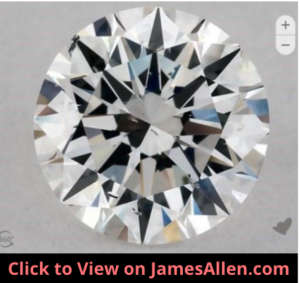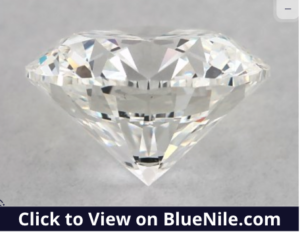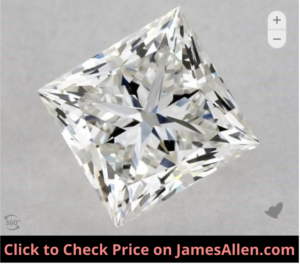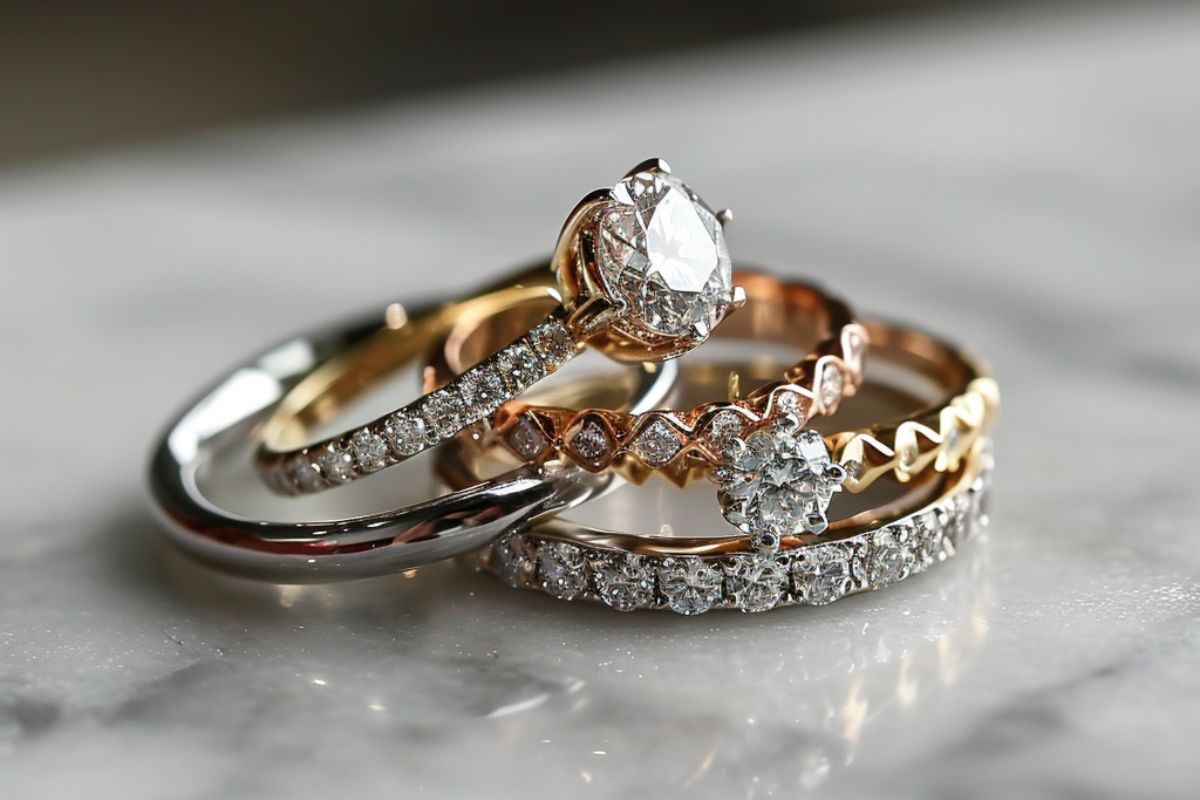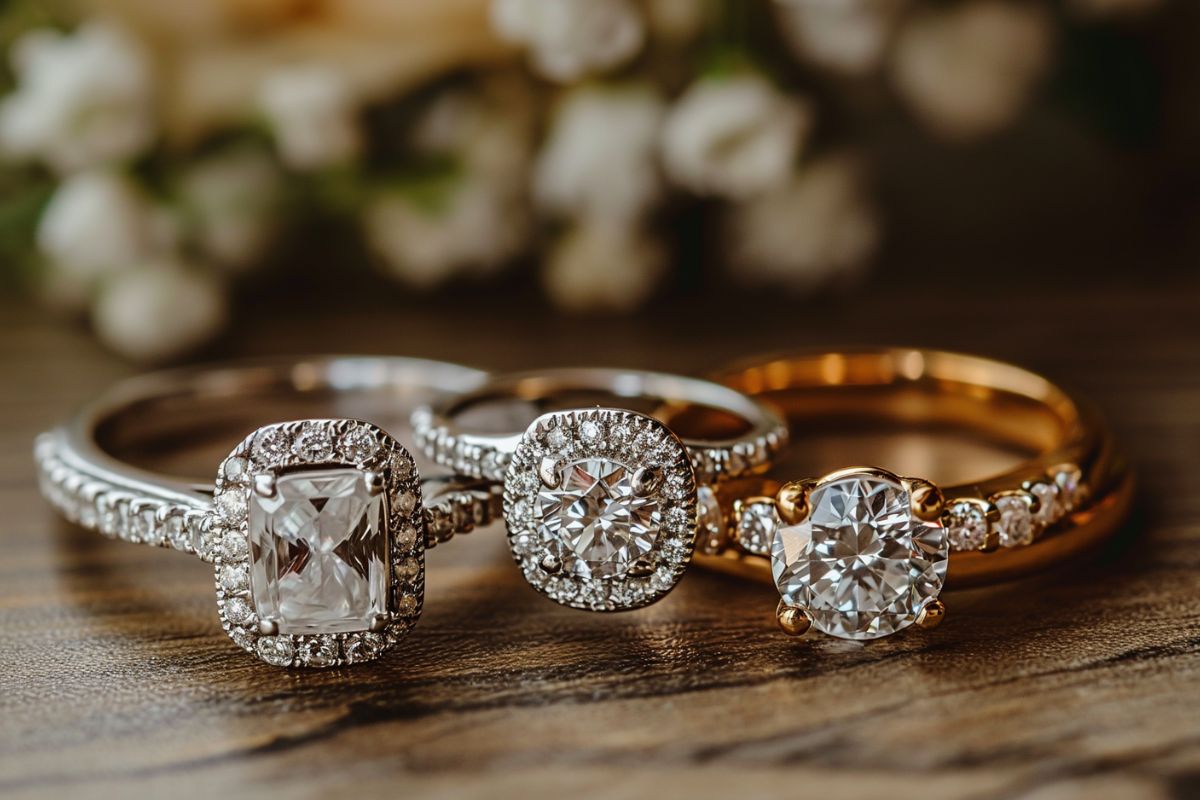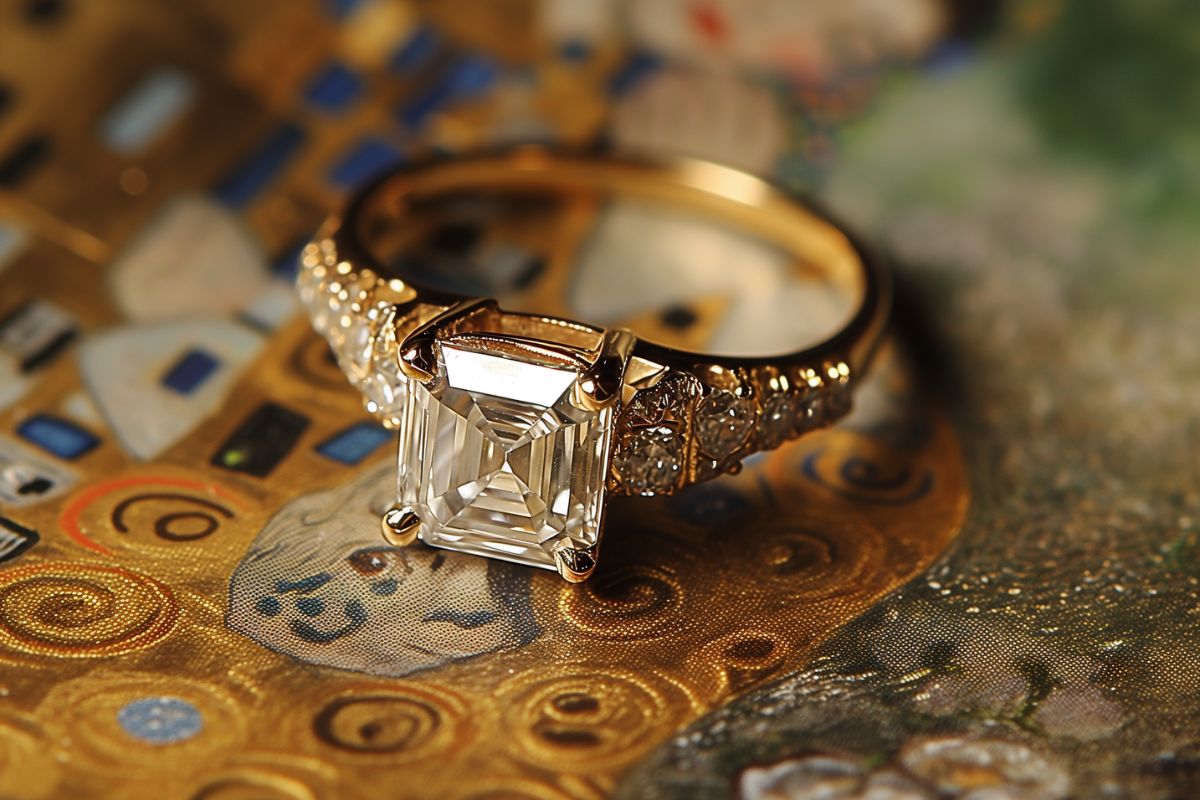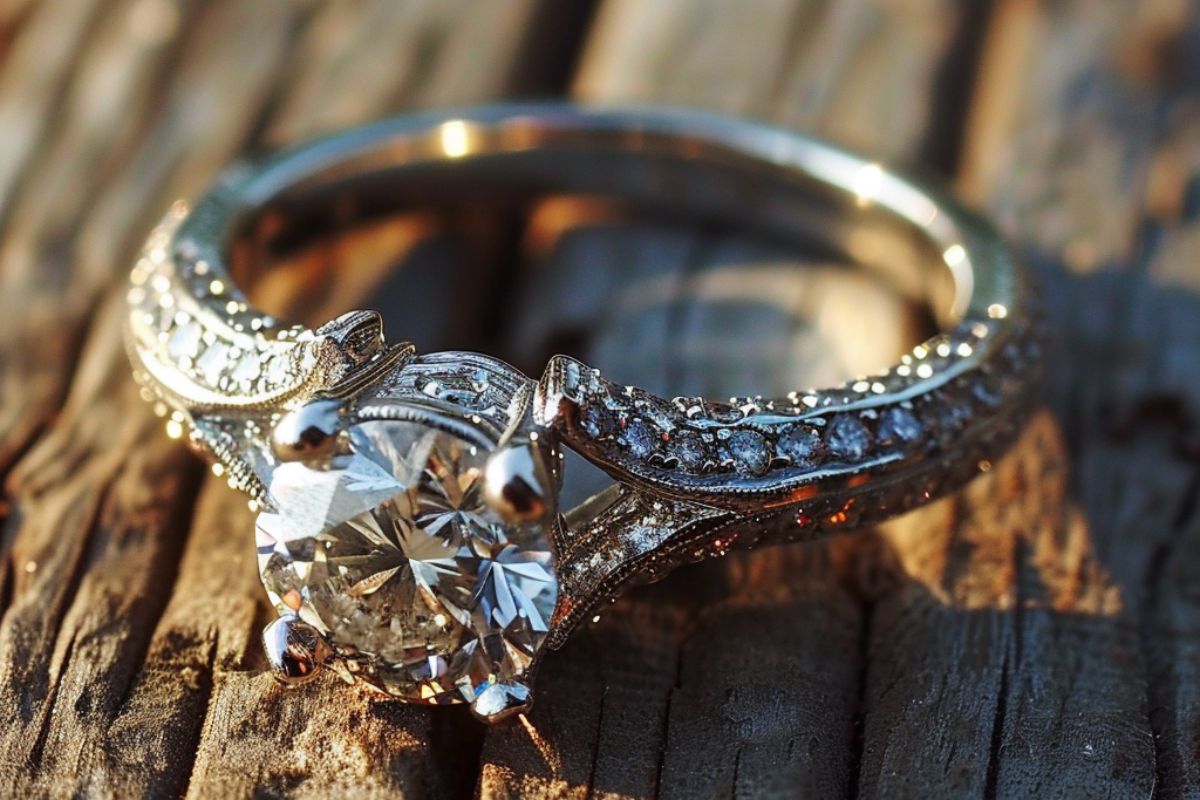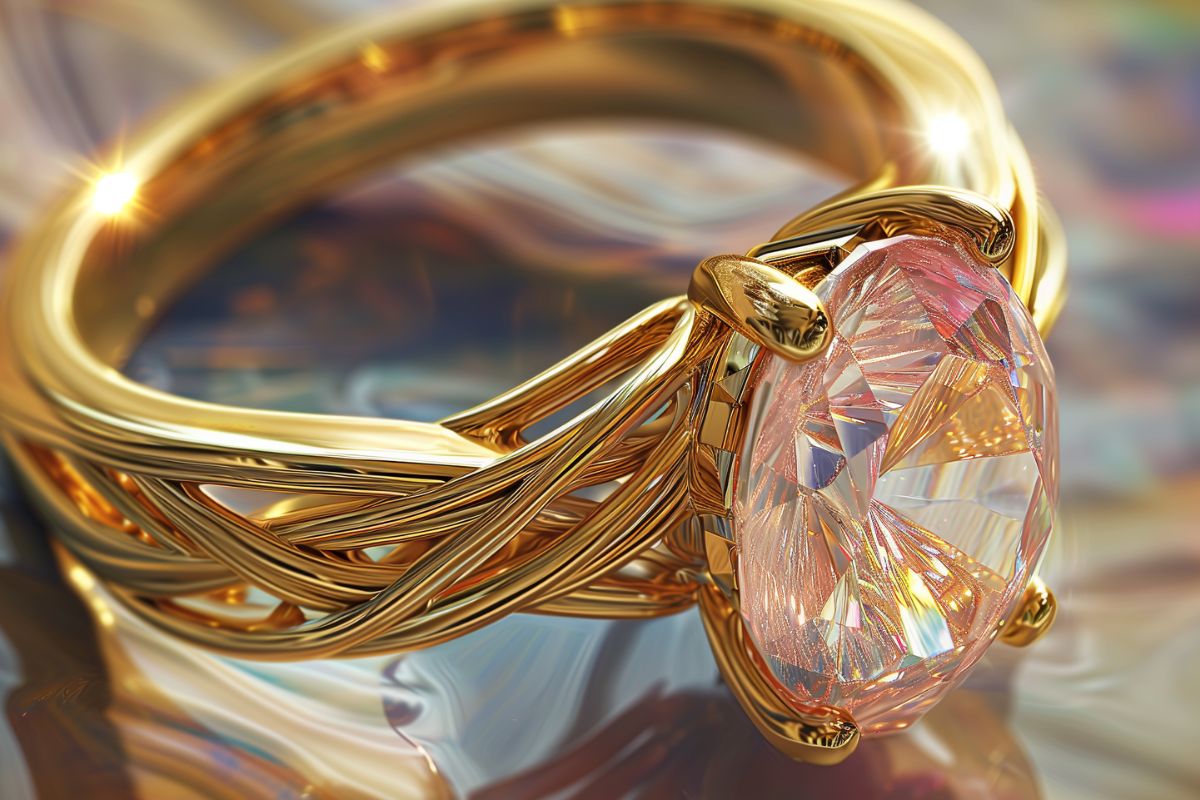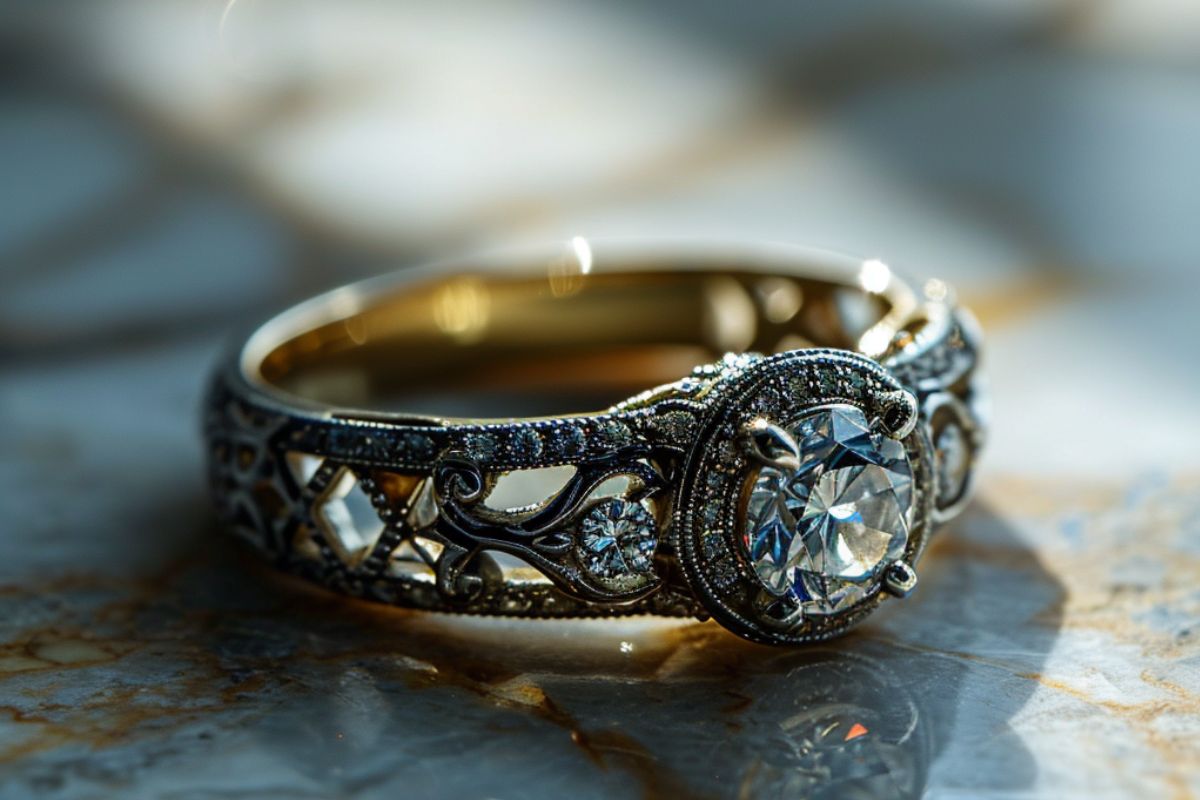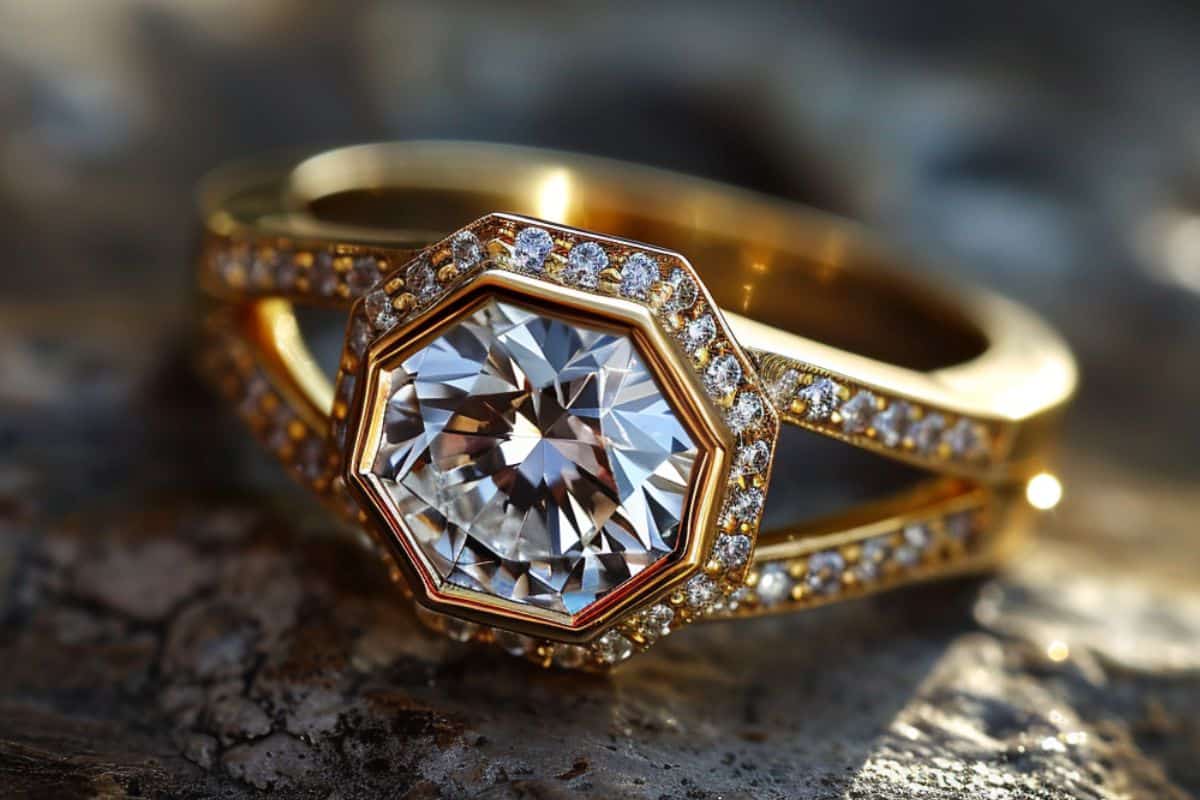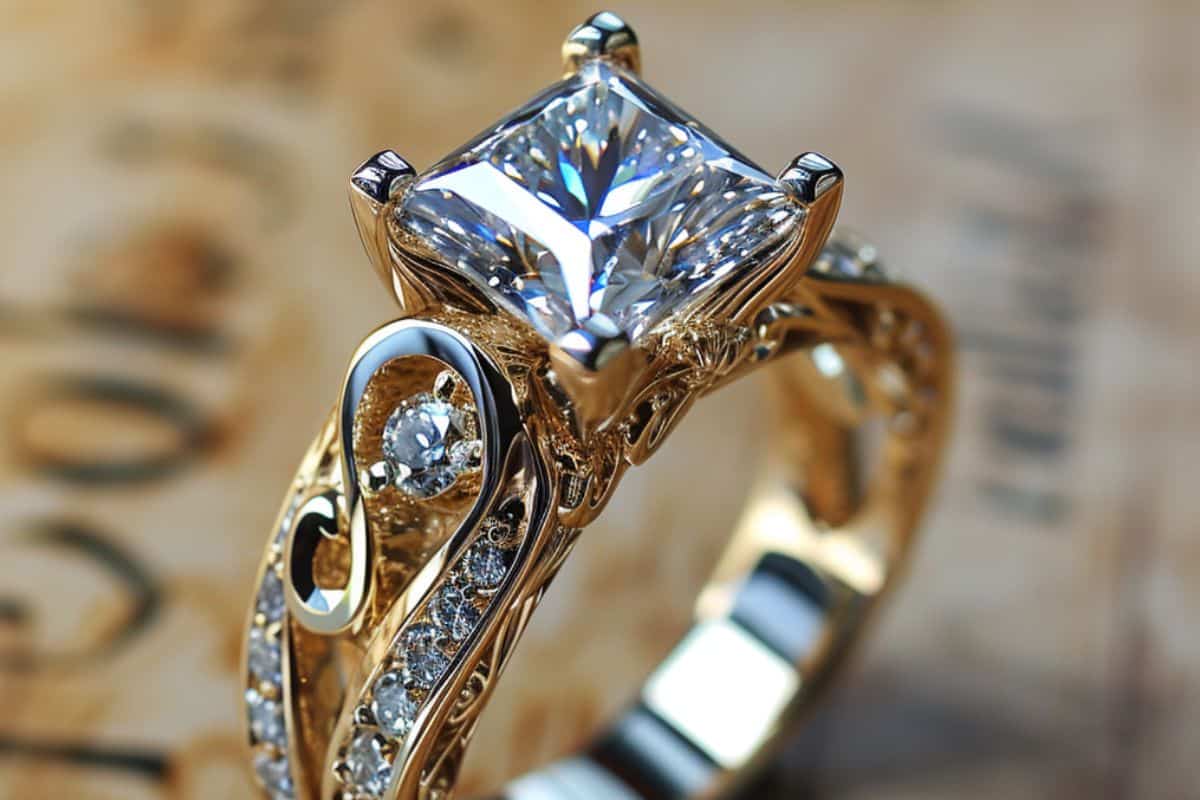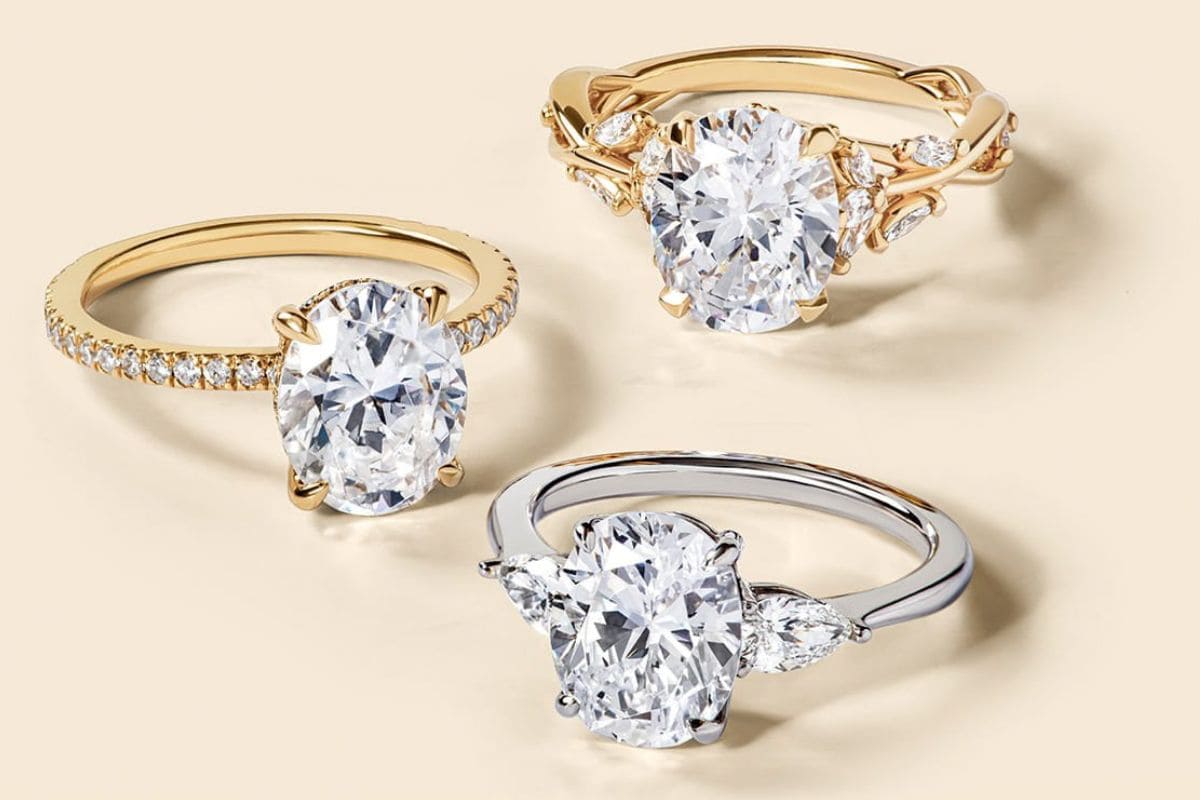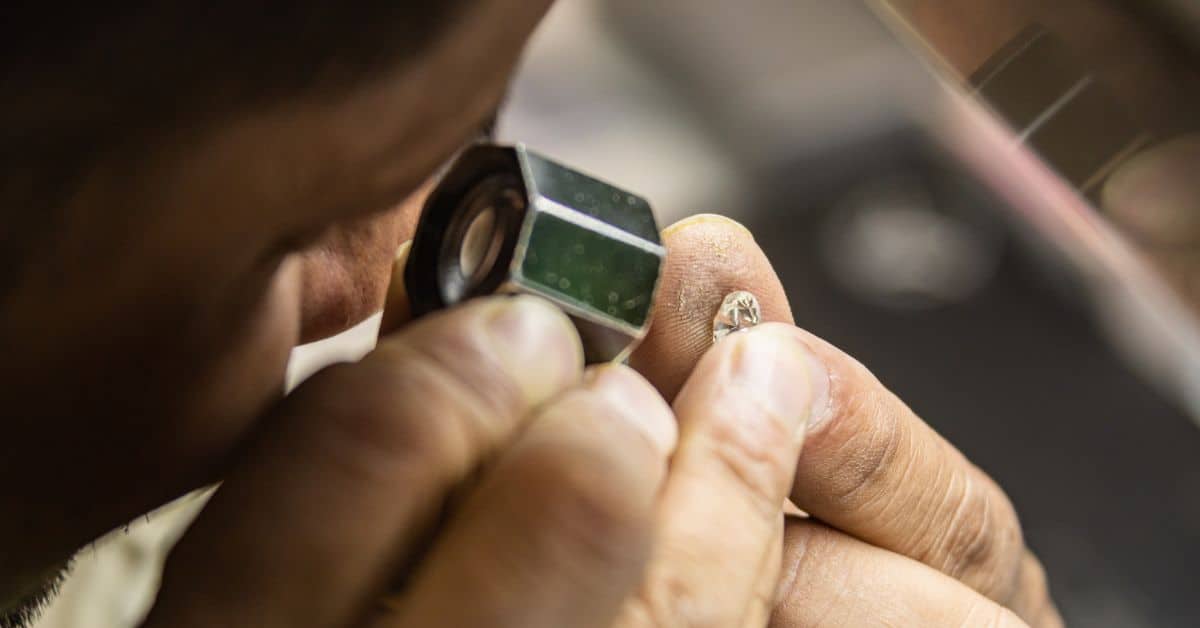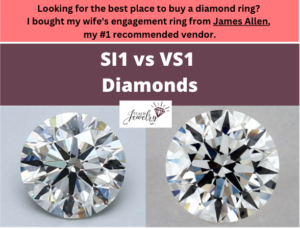
On one end of the diamond clarity scale is flawless, where inclusions aren’t visible with 10x magnification. On the other end is I3, which means there are significant blemishes.
The main difference between SI1 and VS1 diamonds is SI1 diamonds have inclusions that are more impactful on its overall quality. The imperfections in diamonds graded VS1 often aren’t noticeable without magnification, so it appears flawless to the naked eye. VS1 results in a higher price.
For my wife’s engagement ring, I bought her a round-cut VS1 diamond from James Allen.
So let’s compare SI1 versus VS1 diamonds, including an overview of each grade, their differences, and how to know which clarity grade is right for you.
What is SI1 Diamond Clarity?
An SI1 (slightly included) diamond has inclusions visible with a standard jeweler’s loupe at 10x magnification. Sometimes they’re also apparent without magnification.
Here’s an image of an SI1 diamond.
If you check out the gem on the vendor’s website, you can rotate it 360 degrees in high-resolution to learn how it appears at every angle.
On the GIA clarity scale, SI1 is one grade below VS2 and one above SI2.
The grade isn’t referring to any specific type of inclusion within the diamond, such as clouds, cavities, or indented naturals.
Instead, the gemologist combines a number of factors to determine the overall grade, such as:
- The size of the inclusions
- Their position
- Variety of clarity characteristics
- Visibility
- How they affect brilliance and fire
- Potential impact on durability
The diamond is assigned a grade based on these qualities.
In short, the inclusions in SI1 diamonds, compared to VS2, are more impactful. But they’re less so than ones that earn a lower grade.
For example, this 1.02 carat round diamond, from the vendor where I bought my wife’s engagement ring, earned an SI1 clarity grade.
It has a few black spots scattered across its table, which are likely the result of crystalized carbon.
The GIA report includes a clarity plot that shows their size, relative impact, and position.
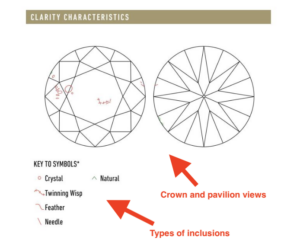
Obtaining a GIA report allows you to learn the details of its SI1 clarity grade.
What is a VS1 Diamond?
VS1 (very slightly included) diamonds have inclusions barely visible at 10x magnification.
Using a jeweler’s loupe, the gemologist may have to scan the diamond a few times before identifying any specific inclusions.
Similar to other clarity grades, a VS1 designation isn’t referring to any one type of flaw.
They may have etch channels, feathers, naturals, or a cavity.
It could be a combination of multiple inclusions, or several instances of one type.
As an example, this VS1 diamond has a crystal and pinpoints.
The clarity plot shows only one occurrence of each, and both are small.
These minor inclusions, combined with diamond weighing only 0.90 carats, means these inclusions likely aren’t visible to the naked eye.
The two imperfections kept it from earning a VVS (very very slightly included) clarity grade but aren’t enough to have a significant effect on the diamond’s appearance or brilliance.
In fact, if you placed a VS1 clarity diamond next to a VVS2 or VS2 diamond, you couldn’t tell the difference without magnification because the inclusions in all of them are minor.
This was the reason I chose a VS1 diamond. As we’ll discuss below, the cost savings were significant compared to ones with higher grades, but the naked eye can’t distinguish between them.
What are the Differences Between SI1 and VS1 Diamonds?
1. Number of Inclusions
In most cases, VS1 diamonds have fewer inclusions than ones that earn an SI1 grade.
The number of blemishes is only one factor that determines clarity grade, but a high number will likely prevent the diamond from reaching the very slightly included status and especially VVS, internally flawless (IF), or flawless (FL).
To illustrate, let’s compare two cushion cut diamonds. This one earned a VS1 clarity grade, and this diamond was graded SI1.
The GIA clarity plot shows the VS1 diamond has crystals, pinpoints, and naturals.
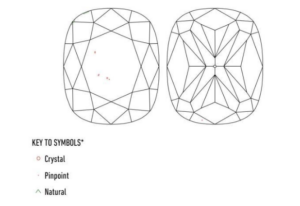
Both are so small they’re barely visible on the report, especially the natural.
But if you look closely, there are a few crystals toward the center of its table.
If you view the diamond without magnification, you can’t see any of the inclusions.
The SI1 diamond, on the other hand, has five types of inclusions:
- Crystals
- Feathers
- Clouds
- Needles
- Indented naturals
- Naturals
All are visible on the GIA report and cover its table and pavilion.
Their location prevents you from disguising them with the setting, so any dark or large inclusions could be visible to the naked eye.
In rare cases, a diamond could earn an SI1 clarity grade because of one or two inclusions.
If they’re large enough or have an adverse effect on its durability, it could be a single twinning wisp or feather that brings it from flawless to SI1.
But in most cases, you’ll be dealing with three to five types of inclusions for SI1 clarity and two or three for VS1 diamonds.
2. Impact of Flaws
One of the criteria gemologists use to assign clarity grades is how much the inclusions affect the performance of a diamond, which generally fall into three categories:
- Appearance
- Durability
- Brilliance
Most buyers want a diamond that displays fire and brilliance and doesn’t have visible flaws or durability issues.
The higher a diamond lands on the clarity scale, the more likely it is to reach this ideal standard.
VS1 diamonds meet this criteria more than SI1 diamonds.
Inclusions that result in a VS1 grade often have no impact on its appearance and have a minimal effect on durability and brilliance.
First, you only have to worry about the visibility of inclusions in a VS1 diamond if it’s over two carats. The large surface area on these diamonds means small blemishes are more likely to be noticeable.
Any weight less than two carats means it’s likely eye-clean.
Take this VS1 princess cut as an example.
The GIA report shows the presence of five types of clarity characteristics, but they have no obvious impact on its appearance.
These inclusions also don’t result in durability issues. Diamonds with large inclusions, or ones near vulnerable areas like an extremely thin girdle, may result in a chip, but VS1 diamonds don’t fall into that category.
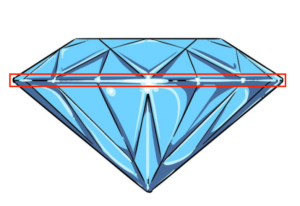
Large feathers or cavities cause the most concern because they represent weak points in its structure.
Although inclusions affect how light can enter and exit a diamond, the most important quality to enhance the brilliance of a diamond is cut.
An excellent cut diamond can exhibit sparkle even with the small inclusions in a VS1 diamond.
These qualities are similar in an SI1 diamond but to a lesser extent.
The higher number of inclusions, or their size and position, means they will have more of an effect on appearance, durability, and brilliance but less than you would experience with an SI2 or I1 diamond.
3. Prices
Buyers are willing to pay premiums for diamonds that score higher across the four Cs of color, carat, cut, and clarity.
VS1 diamonds have better clarity than ones graded SI1, so they’re more expensive.
The best way to understand how clarity affects the price of a diamond is to compare ones that have similar grades across all other qualities.
I examined prices for round cut diamonds from James Allen with the following qualities:
- Carat weight: 1.05
- Cut: Excellent
- Color: H
For diamonds with a VS1 clarity grade, the average price is $7,307, with a range of $6,300-$8,120.
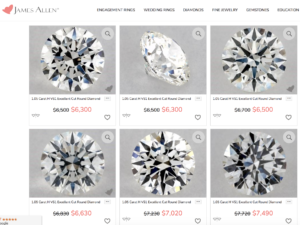
For ones graded SI1, the average cost is $5,993, and the range is $5,070-$6,900.
That’s an 18 percent lower cost for an SI1 versus VS1 diamond.
To the naked eye, most of those diamonds will look identical, but there’s a higher charge for the ones with fewer inclusions.
That’s why I recommend choosing an eye-clean diamond while avoiding the premiums for ones with very few inclusions.
SI1 and VS1 diamonds can fall into that category, but you should still examine them individually. To be clear, those two grades are not automatic indicators the flaws are invisible.
As a general rule, you can expect the price of a diamond to increase 10-20 percent for every step up the clarity scale.
The difference is more pronounced when moving from one category to the next, like SI and to VS or IF and FL.
4. Use in Engagement Rings
Buyers choose VS1 diamonds for engagement rings more often than SI1 because of the diamond’s prominence in the piece.
Even though not every SI1 diamond shows blemishes, buyers are willing to pay a slight premium to ensure its cleanliness.
That was my exact experience when searching for my wife’s ring.
I knew I could save 10-20 percent with a VS2 or SI1 clarity diamond, but I wasn’t interested in saving every dollar I could on such an important purchase.
A VS1 clarity grade struck the right balance between avoiding the high prices of VVS, IF, or FL grades, while still offering the satisfaction of a clean diamond.
The round-cut also had the other factors I was looking for, so I wasn’t hung up on the difference between one or two clarity grades that weren’t noticeable anyway.
But this story isn’t prescriptive. In fact, I often recommend starting with SI1 and working your way up the scale to find the right diamond for your engagement ring.
Should You Choose an SI1 or VS1 Diamond?
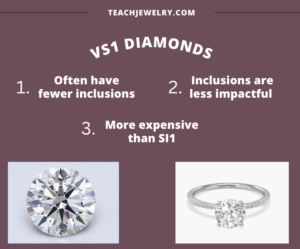
If you’re searching for a diamond, compare SI1 versus VS1 diamonds as potential picks. Both can serve as the center diamond on an engagement ring as an eye-clean, sparkling gem.
Here are some tips to help you choose.
Opt for an SI1 diamond if:
- You’re looking for the most affordable option that still has the potential to be eye-clean
- You want to put your savings from the center diamond toward other qualities about the ring such as its carat weight or setting
- You’ve examined the diamond in person or through high-resolution images
Consider a VS1 diamond if:
- You want more confidence the inclusions are only visible with magnification
- You’re willing to pay a premium compared to diamonds with lower clarity grades
- The diamond weighs more than two carats
Explore SI1 and VS1 diamonds at online and in-person vendors. By pairing them with different settings, you’ll find the right combination for your diamond ring.
Clarity Clarified: Your Questions Answered
Q1: Are there specific types of inclusions that are more commonly found in SI1 diamonds compared to VS1 diamonds?
A1: SI1 diamonds tend to have more visible inclusions such as crystals, feathers, and clouds compared to VS1 diamonds which might have smaller or less noticeable inclusions like pinpoints or tiny crystals.
Q2: How do the inclusions in SI1 and VS1 diamonds affect the resale value?
A2: Generally, diamonds with higher clarity grades like VS1 may have better resale value compared to those with lower clarity grades like SI1 due to the fewer and less noticeable inclusions. The perceived quality and rarity of higher clarity diamonds often make them more desirable in the resale market.
Q3: Are there settings that might complement or mask the inclusions in SI1 diamonds?
A3: Yes, certain settings like bezel or halo settings can help to mask or distract from the inclusions in SI1 diamonds. Additionally, using prongs to cover noticeable inclusions can also be a smart way to enhance the appearance of SI1 diamonds.
Q4: How does the cut of a diamond interact with its clarity grade, particularly in SI1 and VS1 diamonds?
A4: An excellent cut can significantly enhance the brilliance and fire of a diamond, potentially drawing attention away from inclusions. This is particularly beneficial for SI1 diamonds, where inclusions might be more noticeable. On the other hand, a well-cut VS1 diamond might appear almost flawless, with its inclusions being hard to detect even under magnification.
Q5: Can SI1 and VS1 diamonds be considered as good investments?
A5: While both SI1 and VS1 diamonds offer a blend of quality and value, VS1 diamonds are often seen as a better investment due to their higher clarity grade. However, if an SI1 diamond is eye-clean and well-cut, it can also hold value well. It’s essential to consider other factors like cut, color, and carat weight when evaluating a diamond’s investment potential.
Q6: Are there certification labs that are more lenient or strict when grading SI1 and VS1 diamonds?
A6: Different labs may have slightly varying standards, but the most reputable ones like the Gemological Institute of America (GIA) maintain stringent grading criteria. It’s advisable to stick with diamonds graded by well-established labs to ensure the accuracy of the clarity grade assigned.
Q7: How does the size of the diamond affect the visibility of inclusions in SI1 and VS1 diamonds?
A7: The visibility of inclusions can be more apparent in larger diamonds. In SI1 diamonds, inclusions might be visible to the naked eye, especially in diamonds larger than 2 carats. In contrast, VS1 diamonds, even of a larger size, often have inclusions that are difficult to detect without magnification.
Q8: Is there a notable difference in the sparkle between SI1 and VS1 diamonds due to their clarity grades?
A8: The sparkle of a diamond is more influenced by its cut rather than its clarity grade. However, the fewer and smaller inclusions in VS1 diamonds might allow for a slightly better light performance, contributing to a bit more sparkle compared to SI1 diamonds with larger or more noticeable inclusions.
Q9: Is it common for jewelers to offer a wider variety of VS1 diamonds compared to SI1 diamonds?
A9: The availability may vary from one jeweler to another. Some jewelers may offer a wider variety of VS1 diamonds due to their higher clarity grade and perceived value, while others might have a diverse range of SI1 diamonds for budget-conscious customers seeking eye-clean options.
Q10: Are there other clarity grades that offer a better balance between cost and visible inclusions than SI1 and VS1?
A10: Some buyers find that VS2 diamonds offer a good balance between cost and visible inclusions, as they are often less expensive than VS1 diamonds while still having minor inclusions that are difficult to detect without magnification. It’s always advisable to examine diamonds personally or through high-resolution imagery to assess the visibility and impact of inclusions.

Jacob Clarke
Jacob Clarke is the founder of TeachJewelry.com.
He earned an Applied Jewelry Professional Diploma from the Gemological Institute of America (GIA) and now brings you essential information about diamonds, settings, and more.
Jacob has consulted with leading jewelry brands, and his work has been cited in Clean Origin, Diamond Nexus and industry publications.
He's also a member of the International Gem Society.
He enjoys discussing jewelry with readers, so contact him with any questions at jacob.clarke@teachjewelry.com.

